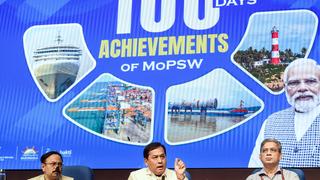A quarter century after Kamarajar Port was named the country’s 12th major port, the mega international container transshipment port (ICTP) at Galathea Bay — in the Great Nicobar island in the Bay of Bengal — has been notified as the 13th major port. This paves the way for the development of the port, which could prove a game changer for maritime trade in the region.
The ICTP, with a 20m natural draught, will be strategically located on the East-West international trade and shipping route in proximity to transshipment terminals like Singapore, Klang and Colombo. It is also a part of the rapidly evolving Indo-Pacific geopolitical region. As a gateway to the region, it will capture transshipment cargo from Indian east coast ports, as also Bangladesh and Myanmar.
The Great Nicobar island, part of the Union territory of Andaman and Nicobar islands, is 40 nautical miles from Malacca Strait — the international shipping channel catering to about 35 per cent of the annual global sea trade. Currently nearly 75 per cent of India’s transshipped cargo is handled at overseas ports. Colombo, Singapore and Klang cumulatively handle more than 85 per cent of this cargo, with 45 per cent going to Colombo port. The ICTP at Galathea Bay can save Indian ports $200-220 million each year in transshipment charges.
Eco-sensitive zone
However, the port’s development faces several challenges, since it is in an ecologically sensitive region.
According to a government source, “The consultants will have to work out a plan without affecting the region’s eco-sensitivity. That is the mandate. They will accordingly seek proposals from contractors and implement these in a phased manner.”
Also read
The ICTP is envisaged to be developed in four phases at an estimated cost of ₹41,000 crore. Phase 1 is expected to be commissioned in 2028 with a handling capacity of around 4 million TEUs, which will go up to 16 million TEUs in the final stage of development. The estimated cost for phase 1 is ₹18,000 crore, which covers dredging, reclamation, construction of breakwaters, berths, storage areas, buildings and utilities, procurement and installation of equipment, and the development of a port colony with core infrastructure, with government support.
Cargo pipeline
Jagannarayan Padmanabhan, Senior Director and Global Head (transport, mobility and logistics consulting), CRISIL Market Intelligence and Analytics, says the Galathea Bay port project does have a lot of potential, but the absence of immediate hinterland cargo may see the port struggling to attract regular shipping lines and transshipment business. This could impact its competitiveness vis-a-vis other established ports in the region that have strong local and regional cargo support.
To mitigate this challenge, project planners must develop strategies to attract cargo, including offering competitive tariffs, ensuring efficient logistics services, and, possibly, developing industrial zones nearby to generate cargo. Improved maritime and air links with the Indian mainland could help generate a more sustainable cargo base.
Funding support
Other execution challenges for the Galathea port include the transportation of construction material, such as the stones needed for the breakwater, from long distances.
The status change to major port will help access central government financing, says Varun Gogia, Assistant Vice-President, ICRA. Pointing out that JNPA has declined to fund the Galathea port as it has the Vadhavan port construction on its hand, Gogia says the government must look for a strong partner to execute the project or provide significant viability gap funding to attract private players.








Comments
Comments have to be in English, and in full sentences. They cannot be abusive or personal. Please abide by our community guidelines for posting your comments.
We have migrated to a new commenting platform. If you are already a registered user of TheHindu Businessline and logged in, you may continue to engage with our articles. If you do not have an account please register and login to post comments. Users can access their older comments by logging into their accounts on Vuukle.